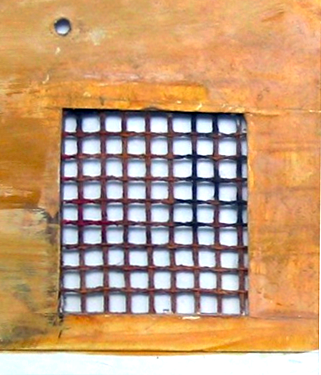„We shared a lot of ideas and we liked a lot of the same things. (…) We had quite a bit in common beside from the fact that we were friends.“ (Saul Leiter)
I: Street Scenes in Slumberland.
II: On Robert Weaver. Alexander Roob in conversation with Saul Leiter.
III: Robert Weaver: The Vogelman Diary
I: Street Scenes in Slumberland
The opus A Pedestrian View / The Vogelman Diary from 1982 belongs to the key works of American artist Robert Weaver. (1) It consists of fifty-two individual gouaches in plastic sleeves filed in a ring binder. Weaver was a passionate illustrator and from the mid-1950s onward he ranked among the most seminal proponents of his discipline. However, in the glamorous 1980s, when this picture series was created, the appearance of his raw and significant, expressive art was no longer in demand in the large illustrated magazines. His experimental late work, on which he had been working since the mid-1970s, originated free of any restrictions or speculations having to do with assignments – or art-market art – and in total artistic isolation. Each of the late picture cycles or author’s books represented a new and surprising approach to investigating sequentiality in the image, ambulant modes of perception and multi-perspectival narrative strategies; themes that in the context of art became topical in a comparably comprehensive way only as late as the 1990s.
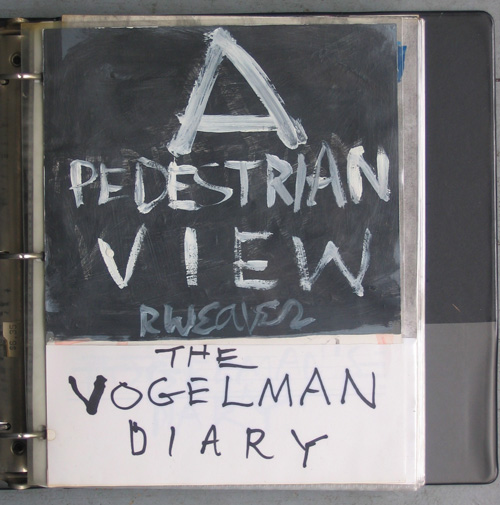
Robert Weaver, A Pedestrian View / The Vogelman Diary, 1982 (Plate 1)
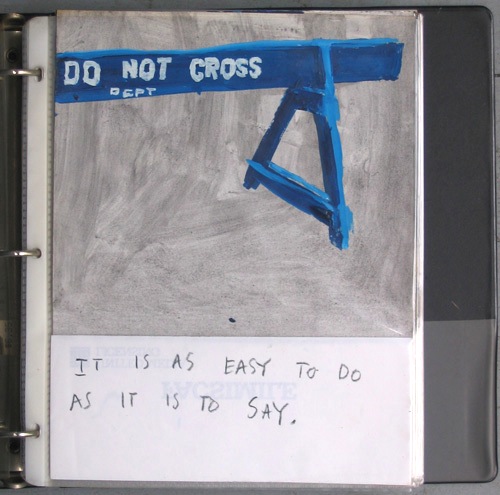
Robert Weaver, A Pedestrian View / The Vogelman Diary, 1982 (Plate 2)
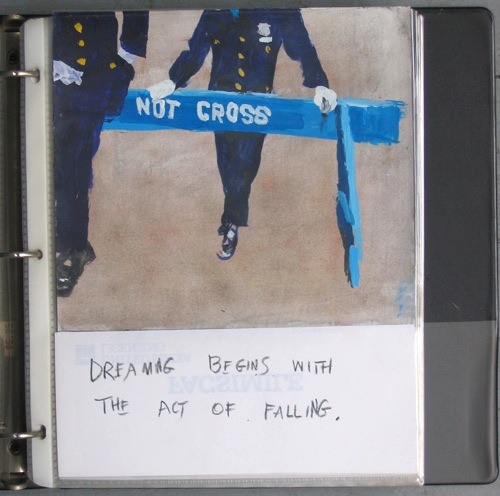
Robert Weaver, A Pedestrian View / The Vogelman Diary, 1982 (Plate 3)
As with most of his picture books, Weaver operates with different narrative frequencies in A Pedestrian View / The Vogelman Diary. The special feature of this two-part work is that the lower layer of The Vogelman Diary consists of pure text. But in relation to the upper pictorial layer, A Pedestrian View, it is not regarded as visually subordinate, because Weaver, in the decisiveness and economy of the chirographic placement, treats it above all as a pictorial phenomenon. The upper picture frequency also possesses a large number of written elements in the form of signs and labels. It is largely composed of a sequence of street scenes that – as the title suggests – are perceived from the perspective of a flâneur.
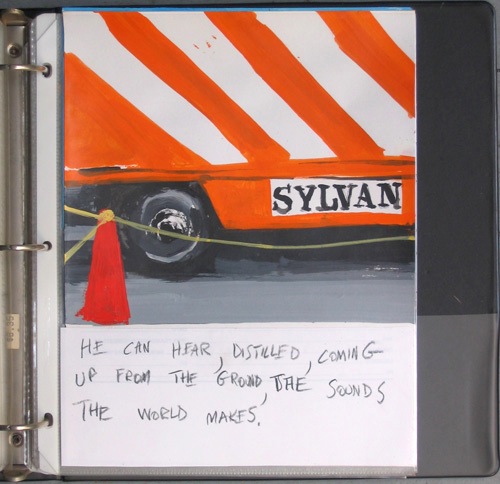
Robert Weaver, A Pedestrian View / The Vogelman Diary, 1982 (Plate 33)
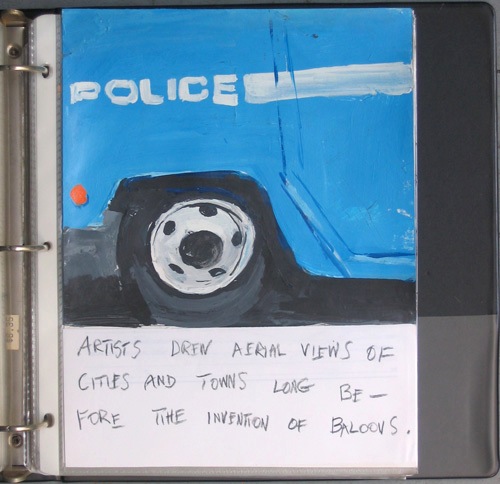
Robert Weaver, A Pedestrian View / The Vogelman Diary, 1982 (Plate 34)
The label “Sylvan” (inhabitant of a forest) on the depiction of a city garbage truck refers to the long tradition of urban journalism. The first professional big-city flâneur, Edward Cave, had signed his London reportages, published at the beginning of the 18th century in the Gentleman’s Magazine, with “Sylvanus Urban”, alluding to the metaphor of the urban jungle. In Weaver’s work, the modern Sylvanus in the hustle and bustle of the metropolis is confronted by an array of oddities that are so subtle that they can often be detected only upon second or third sight. For example, a Chinese laundry with a stuffy, old European decor in its shop window, an old man with a walking stick whose slow trot contrasts the hurried clock pulse suggested by the ad for a wristwatch, quickly striding pedestrians ignoring a peremptory stop sign, a parking car pretending to be in motion, Millet in a can, fortune-telling from a fish soup, and a skater doing pirouettes as a falcon in the asphalt heavens.
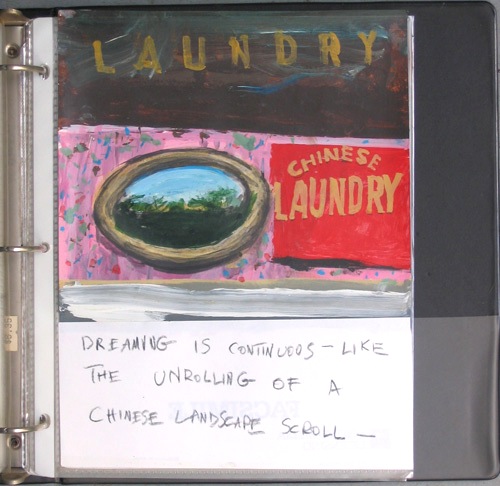
Robert Weaver, A Pedestrian View / The Vogelman Diary, 1982 (Plate 41)
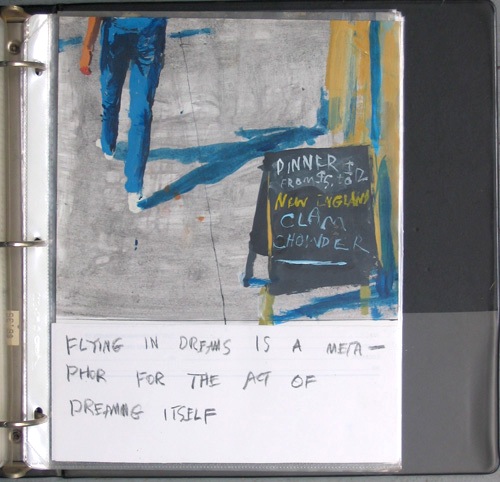
Robert Weaver, A Pedestrian View / The Vogelman Diary, 1982 (Plate 47)
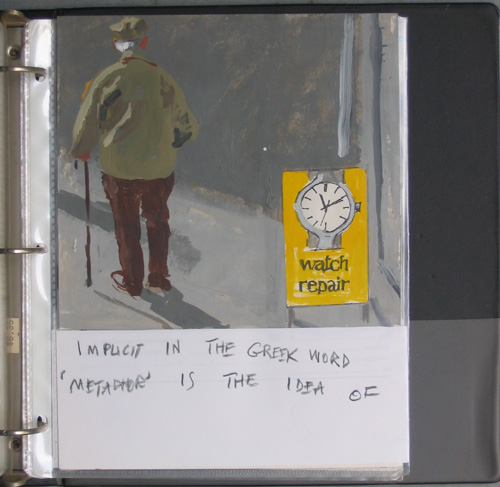
Robert Weaver, A Pedestrian View / The Vogelman Diary, 1982 (Plate 48)
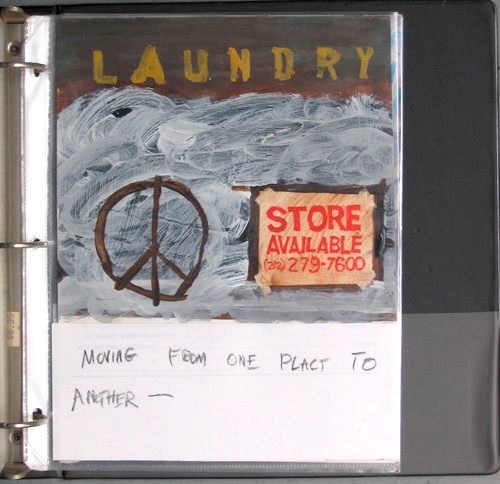
Robert Weaver, A Pedestrian View / The Vogelman Diary, 1982 (Plate 49)
All scenes in Weaver’s book seem to adhere to a strange, trance-like state, an impression reinforced when concurrently reading the lower diary level. It deals with the reflections of a certain Clarence Vogelman (Note: Vogel is the German word for bird) rising to a dream flight over the metropolis as a successor of Theodor Storm’s little Häwelmann and Winsor McCay’s Little Nemo, to then suddenly plunge to the forests of Upstate New York, probably, as is said, due to a bullet fired by a duck hunter. In Clarence Vogelman’s ongoing monologue, Weaver ties in several media-theoretical reflections in the vein of Marshall McLuhan. In the form of the Chinese picture scroll, he attributes McLuhan’s manuscript culture to the imaginary world of the state of dreaming, while the discontinuous waking consciousness, which is more strongly subjected to the rule of language, is attributed to book culture. Weaver’s opus itself consists of a superimposition of these two media. It represents neither a continuous flow of images nor the discontinuous book form but balances between the states of dreaming and waking.

Robert Weaver, A Pedestrian View / The Vogelman Diary, 1982 (Plate 10)

Robert Weaver, A Pedestrian View / The Vogelman Diary, 1982 (Plate 11)
Transgression is the leitmotif of A Pedestrian View / The Vogelman Diary. Weaver blurs the borders between image and writing through the permanent change of form, not in the style of an artistic synthesis and a temporal parsing as is the case in comic strips, but in an organic fashion by developing a network of open, rebus-like references and letting the text mutate into an image and vice versa. To the same degree as he transforms the textual content of The Vogelman Diary into an expressive image form, he succeeds in translating the pictorial content of A Pedestrian View into a meta-language composed of free-floating characters. Weaver’s enigmatic picture alphabet starts with the initial A on the cover, which on the following pages first turns into a trestle of a police roadblock, then into a construction site barricade and the gait of a passer-by; it ends on the last page with the letter O in the representation of a warning sign: “Do Not Enter”.
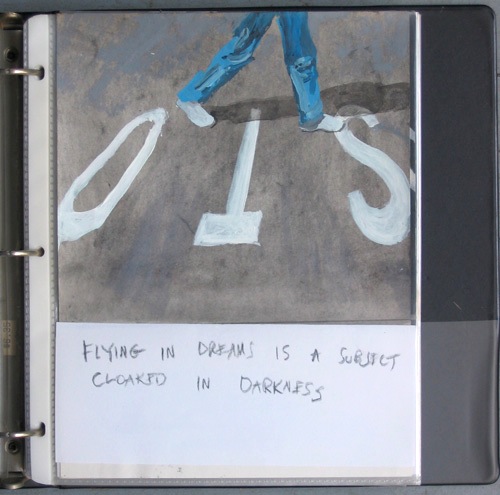
Robert Weaver, A Pedestrian View / The Vogelman Diary, 1982 (Plate 12)
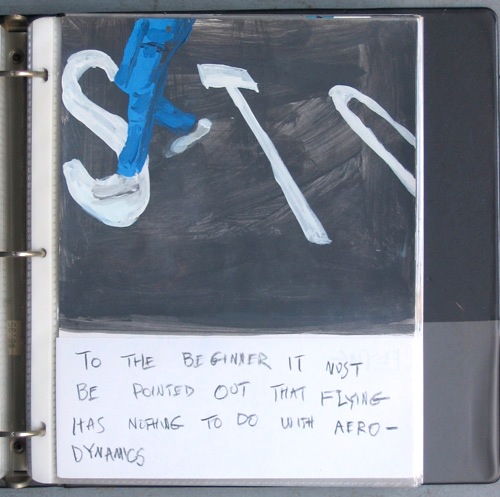
Robert Weaver, A Pedestrian View / The Vogelman Diary, 1982 (Plate 13)
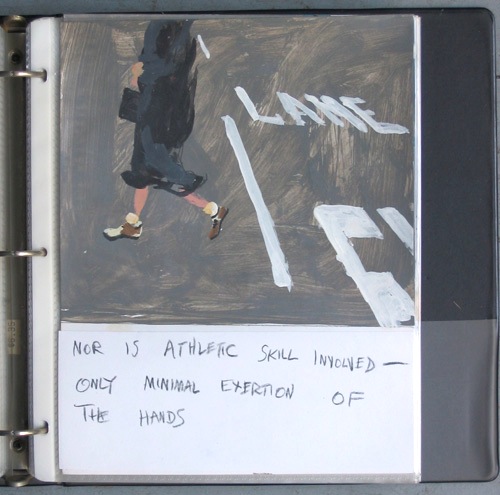
Robert Weaver, A Pedestrian View / The Vogelman Diary, 1982 (Plate 14)
While the text part begins with an act of expansion, falling into a floating state of dreaming, the pictorial level is blocked in the back and front. On the upper level of the pedestrian’s perspective, the clear view of Clarence Vogelman, the fictitious author of the dream diary, is literally obstructed. He experiences real clearance (Clarence) only in the unfolding perspective of introspection. To arrive at an unobstructed picture of reality, the limited retinal view must be supplemented by the overtone-like bird frequency of a visionary top view and phantom view.
Here, Weaver metaphorically addresses the gradual loss of his own sight. He suffered from glaucoma and, following several unsuccessful operations, was almost blind when he made the book. Even with the aid of microscopic lenses he could no longer read a book, – but he could draw one. Visual journalism, for which he stood in the illustration business, experiences a turn to the inside, as in other cycles of his late work. At issue is an opening or clearance, beyond the barriers of retinality, to a trans-pictorial, metaphoric, intermediate space. The metaphor of the Chinese laundry, or cleaner’s, which appears twice in A Pedestrian View, plays a role here.
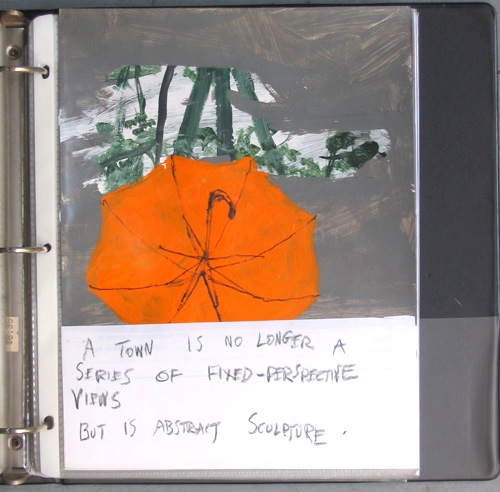
Robert Weaver, A Pedestrian View / The Vogelman Diary, 1982 (Plate 30)
Weaver was an admirer of William Carlos Williams’ Imagist poetry with its attempt at establishing a picture language of the concrete. Williams was inspired by Ezra Pound’s ideogrammic method that was based on an analysis of Chinese characters. The process of image conception that Weaver developed in his late work was basically an application of this ideogrammic method of Imagism to the perspectival image space. To do so, the level of photographic reality had to be disassembled to the simplest sign structures. What assisted him in this respect, apart from his extreme visual impairment that forced him to painterly reduction, was foremost his analysis of Edgar Degas’ works. In an interview with Sue Gangel, Weaver stated that Degas knew how to playfully handle extremely reduced pictorial elements and thus make his compositional decisions transparent. (2) The picture series of A Pedestrian View reveals how expertly Weaver was able to strike the ideogrammic keys that the examples of Degas and Williams had made accessible to him.
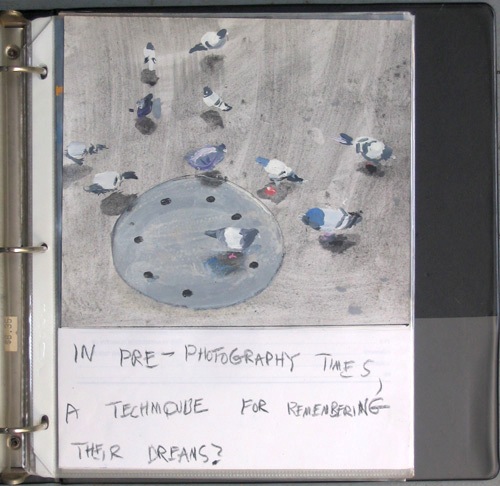
Robert Weaver, A Pedestrian View / The Vogelman Diary, 1982 (Plate 36)
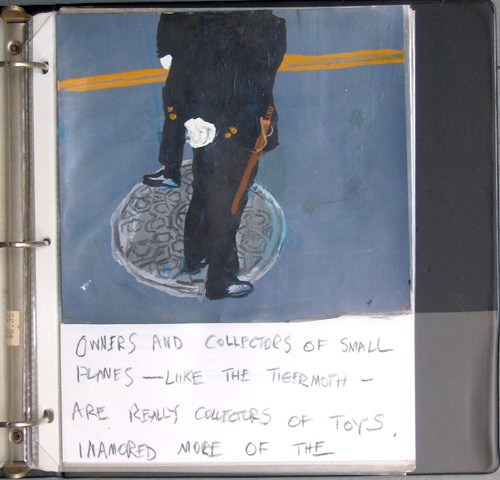
Robert Weaver, A Pedestrian View / The Vogelman Diary, 1982 (Plate 37)
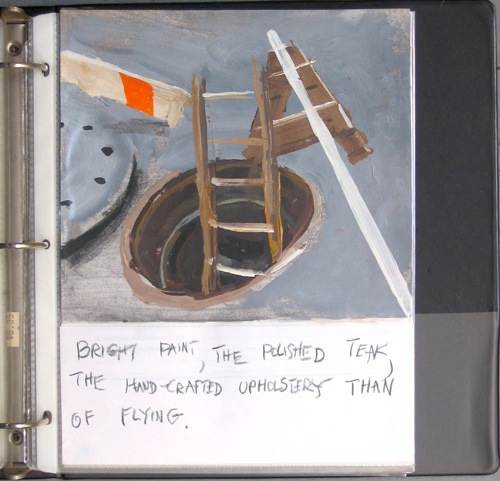
Robert Weaver, A Pedestrian View / The Vogelman Diary, 1982 (Plate 38)
In formal terms, Weaver tried his utmost to ensure a fluid progression of the book, but at one point this flow comes to a halt. It is a truly unwieldy page that, as opposed to all others, is treated on both sides. The picture medium is not paper but two thin wooden panels into which he set a net structure that can be seen from both sides. One can interpret the high degree of abstraction of this matrix-like form in many ways, for example, as a grilled window, as the grid structure of a landscape seen from above, as the discontinuous character of the book form. All of these associations suggest themselves and are supported by text passages, yet they do not explain the irregularity of the work. The ground is given only when it is also seen as a metaphor of the work itself, or of its permeable weave structure. “The Weave” was also the nickname his students had given him at the School of Visual Arts, and so this matrix form can readily be regarded as a self-portrait of the weaver of this work. (3) This intrinsic intarsia that turns the abstract grid of a cityscape seen from above into an image of the organisational structure of the work itself corresponds with the self-reflective metaphor of the dreamt flight as an image of a dream in a dream that is addressed in The Vogelman Diary.
On the penultimate sheet of the book, the round hole placed on this weave is shifted over the matrix itself, which has now mutated into the back wall of a punctured image medium. The photographer with the pointed camera who appears in it, in turn, could be Weaver himself. The face cannot be discerned; it is covered by the camera. Or is the flâneur photographer of A Pedestrian View perhaps someone else, a person to whom a further sheet refers depicting a ladder, which rises up from the circle of a sewage pipe? (Note: Ladder in German means Leiter)
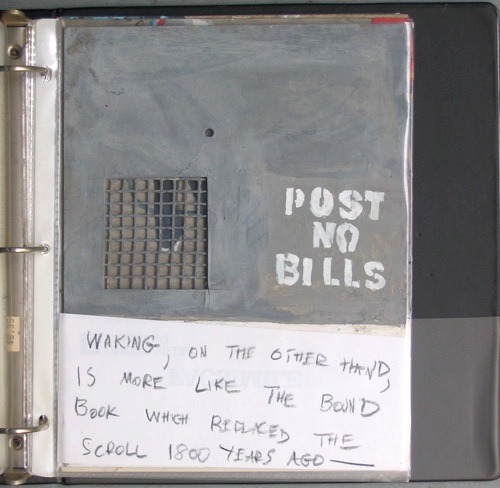
Robert Weaver, A Pedestrian View / The Vogelman Diary, 1982 (Plate 43)
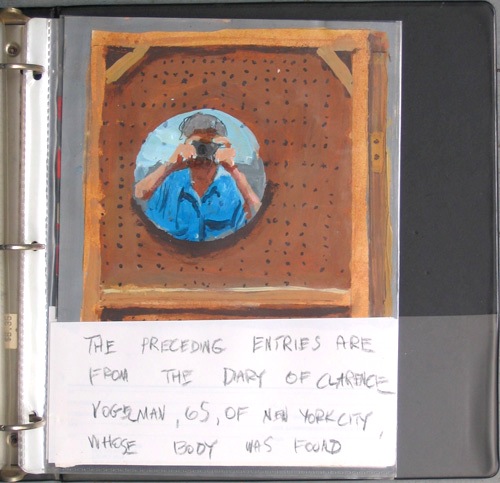
Robert Weaver, A Pedestrian View / The Vogelman Diary, 1982 (Plate 51)
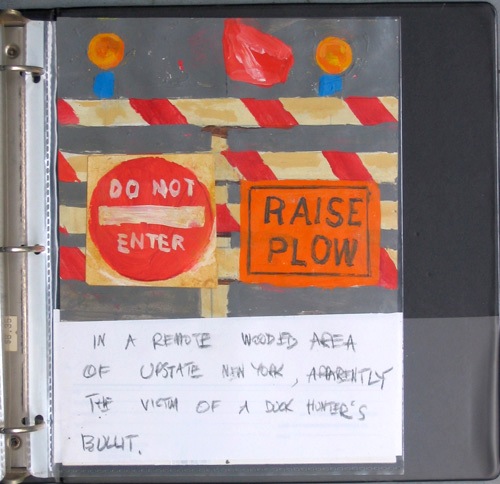
Robert Weaver, A Pedestrian View / The Vogelman Diary, 1982 (Plate 52)
Artist Saul Leiter, a close friend of Weaver, had begun experimenting in the field of colour photography in the late 1940s. Weaver was one of the few witnesses who had followed the development of Leiter’s striking street photographs since the early 1950s. Due to the specific chromaticity, the subtle perspectives and the plane, painterly picture details, a similar feeling of otherworldliness and unreality arises in Leiter’s street pictures as in Weaver’s pedestrian scenes. This hallucinogenic aspect of Leiter’s photographic flâneur activities was already addressed in 1960, in a contribution to the magazine Color Photography. A Popular Photography Annual entitled Saul Leiter´s Dream World. (4)
The dialog that ensued between the two artists had to do not only with their similar composition schemes and the many common art-historical references, but above all with a specific mode of perceiving the urban surroundings as a kaleidoscopic enigma. Leiter’s photographic oeuvre was a background foil against which Weaver was able to develop his metaphoric sign system.
While Weaver’s work, including his independent late work, never met a response in the art context, examples of Saul Leiter’s early photographic work were on view at the Tokyo Museum (1953) and the Museum of Modern Art in New York (1953/1958), among others. Afterwards, they fell into oblivion for a long period of time. “Leiter is a young man not in a hurry,” it was stated in the article Saul Leiter’s Dream World from 1960, and indeed, his works came into the limelight of the art world only four decades later. Since then, tribute has been paid to his oeuvre in a number of important international shows and publications as a substantial artistic contribution to the history of 20th-century photography. (A.R.)
Notes
1) The book is included in the MePri Collection. In November of this year, it will be on view in its entirety for the first time in an exhibition at the Heidelberger Kunstverein.
2) > Communication Arts, May 1978
3) > Alexander Roob: The Weave. Die Lehren des Robert Weaver. In: Elke Bippus, Michael Glasmeier hrsg.: Künstler in der Lehre. Hamburg 2007
4) „One man´s dream is another man´s reality. To almost everyone who sees the photographs of Saul Leiter, they convey a sense of mystery, of the hidden or the undiscovered; the images strike a responsive chord somewhere in the unconscious. They are pictures not readily described or discussed, but deeply felt. If they make us say “unreal” or “weird”, that may only reflect our own misunderstanding of the “real”. For Leiter these are images of actuality, drawn from the most significant layers of awareness, seen in the truest perspectives. (…) Saul Leiter is a young man not in a hurry.“ (H.M. Kinzer, Saul Leiter´s Dream World, in: Color Photography, 1960, p. 46)
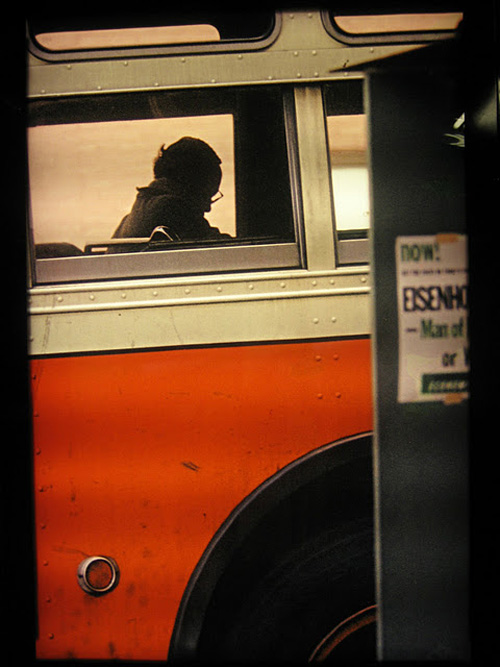
Saul Leiter, Bus, New York 1954
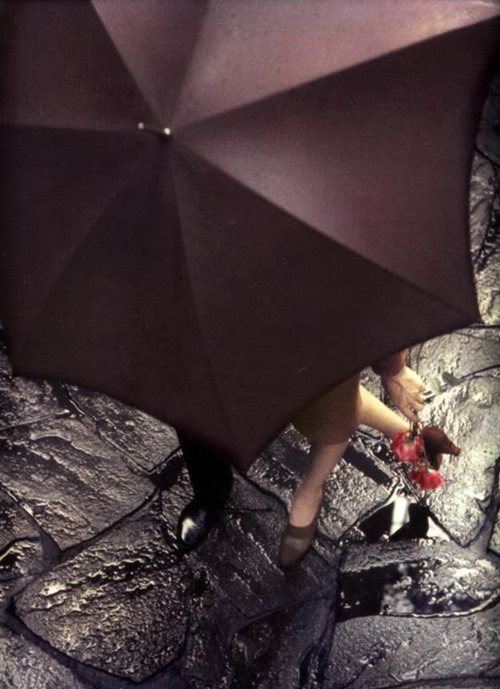
Saul Leiter, Shoe Advertisement for Miller Shoes, 1957
II: On Robert Weaver. Alexander Roob in conversation with Saul Leiter
Alexander Roob: Thank you very much for your willingness to provide informations about your friend Robert Weaver who died in 1994.
Saul Leiter: At first I was shocked, then I was surprised, then I was very, very pleased when I heard what is happening to Bob´s work, that it is being cherished and taken care of and being admired. I´m very happy that it survived, and interests people and will be appreciated more and more. It could so easily have remained in storage and been forgotten. I used to talk to him sometimes about the fact that his work was very fragile and could very easily been damaged if it was not taken care of. Things quite often are thrown away and people are forgotten.
Bob was the typ of being an unusual artist. He was one of the very best friends I ever had and my affection for him was very special. I hated to see him suffer but I admired the fact that under the most difficult circumstances he managed to be productive. We occasionally talked about the operation on his eye which damaged the eye and it was almost heroic how he continued to work – In this late period of my life I have become a little bit known and people come and ask me all kinds of questions and I got to the point where I hate being interviewed. (Laughing) I make a great exception for Bob Weaver. I tell you it is very nice when you spend your life doing things to have certain things admired and to be lucky enough to be alive when it happens, you see ? I wish that Bob had the experience of living longer. He died as I recall of pancreatic cancer and it seems to have happened very quickly with him
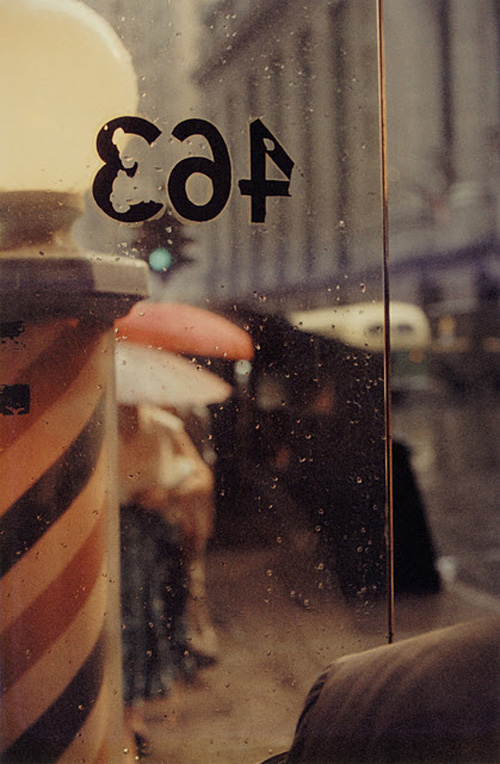
Saul Leiter, 463, 1956
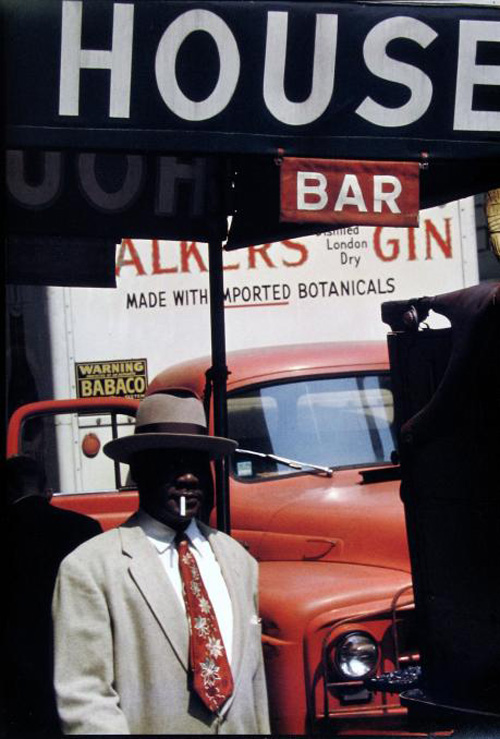
Saul Leiter, Harlem, 1960
A.R.: You both were almost the same age and you both came from the same city, from Pittsburgh, but obviously with very different preconditions. When you started experimenting with photography and abstract painting in New York, Weaver was in Venice practicing frescoe technique and studying Renaissance painting and contemporary Neorealism. Can you tell us how you met?
S.L.: We didn´t meet in Pittsburgh. I think it was Bobby Zelnick who brought him one day over to my apartment in New York. I don´t know exactly when. Zelnick came also from Pittsburgh. He was a realist painter at that time and I believe he has studied with Bob.
A.R.: I presume you met shortly after Weaver came back from his studies in Italy. He settled in New York in 1950.
S.L: Yes, maybe. Later, in 1959 we both went to Europe together. I had an assignment to photograph Gina Lollobrigida in the bathtub but she didn´t want to be photographed. Then I think we went to Rome where we saw Philip Pearlstein, who was a friend and then we went to Venice and I met his aunts and we stayed there a little bit and then we came back.
A.R.: Did you follow the development of his late experimental work, this body of narrative pictorial books?
S.L.: When I knew him he showed certain things to me which I admired very much. But he didn´t, at least with me, spend time discussing the work or talking about it or explaining it. He never talked with me about his work so much. He knew that I admired him and I thought of him. I even used to joke with him and tell him that, when he would be an illustrator, he could be actually a fine art – artist. We would laugh about that and of course at that time he was more interested in being an illustrator, even though his paintings were quite beautiful. The things he did for Life magazine were quite remarkable and it was a great pity that they were not kept together.
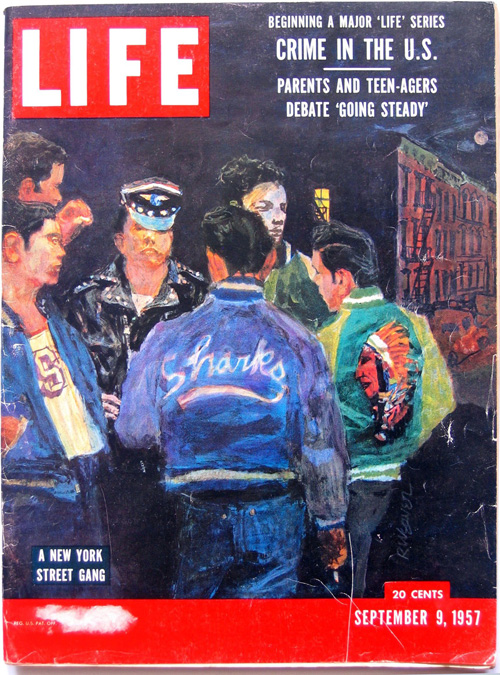
Robert Weaver, Cover for Life Magazine, September 1957
AR.: You both worked in the commercial sector and you both were successful in bringing a fresh experimental and artistic spirit into the applied arts, into fashion photography and the illustration business.
S.L: He, I think was much better at it than I was. He was considered being very unusual by people who cared about illustration and in fact he was among the most unusual people in the field, to put it mildly. I had never been involved in the world of illustration as I have in the world of painting. I told him he had a greater destiny to fulfill. (laughing) He loved illustration, he loved the whole work, he loved dealing with the problems. He had no trouble enjoying the work he did. He was not apologetic about it. He was not like those people who are doing something and wish that they could do something else. Bob was not that way.
A.R.: So for him illustration apparently seemed to be an end in itself, the final aim of his art. But on the other end I heard that from the late Seventies on he had less and less commercial work to do, because he was considered by a new generation of art directors as being difficult to work with.
S.L.: I didn´t know the problems that he had with work. I went to see Henry Wolf at Esquire, because Bob has worked for it and Bob wanted me to see Henry, and Henry was of course a great admirer of Bob´s work. If he had difficulties I did not know what was going on. If so, he was probably right and the people who had difficulties with him were probably wrong.
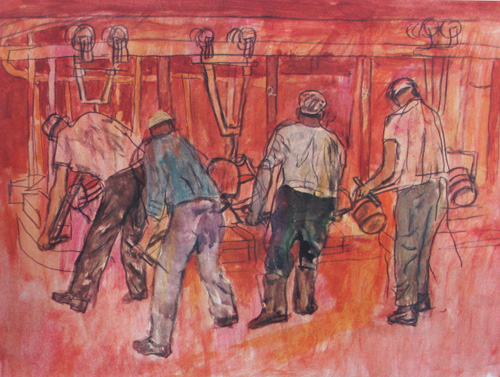
Robert Weaver, Fortune Magazine, November 1957
A.R.: Can you speak about the role of art directors like Henry Wolf of Esquire or Leon Lionni of Fortune Magazine ?
S.L.: I can´t speak of everybody, but of Henry. He became a very good friend of mine. Henry held Bob Weaver for a superb artist. But I don´t know that Henry knew about Bob´s later work. I´m not sure about that.
A.R.: Obviously Weaver´s late uncommercial work was only known by a very small circle.
S.L: This is probably true.
A.R.: In another interview you mentioned that Weaver belonged to the very few people who visited your private slide shows in the Fifties and who accordingly were aware of your early color street photography.
SL: I would from time to time get new boxes of slides and project them. Bob would come over and clap. Dottie (Dorothy Weaver) would also be there.
A.R.: Did Weaver share your artistic enthusiasm with photography? Do you know if he created a photo-archive of his own?
S.L.: Later on Bob did beautiful work which must be somewhere. He had a Roleiflex.
A.R.: I perceive a lot of parallels betweet your painterly way of photography and some of his illustrations and especially of some of his late pictorial books.
S.L.: We shared a lot of ideas and we liked a lot of the same things. At the time for instance he liked Ben Shahn, I liked Ben Shahn. I think we liked certain ways of framing things and organizing them. I think we had quite a bit in common beside from the fact that we were friends.
A.R.: You mention Ben Shahn, this last dinosaur of American social realism, as a common person of reference. Wasn´t it rather precarious in the phobic McCarthy era to work in this spirit of the socio-critical leftist WPA-tradition and of a self-confessed communist like Shahn? Can you recall political discussions with Weaver at that time?
S.L.: I admired some of Ben Shahn’s things but I think Shahn meant more to Bob. I can’t comment on McCarthy. I was not concerned with McCarthy’s issues. As a person Bob was conservative, but what did he feel about McCarthy? Bob´s father was a kind of crank. He had a radio show in Pittsburgh and once criticized women wearing high heels.
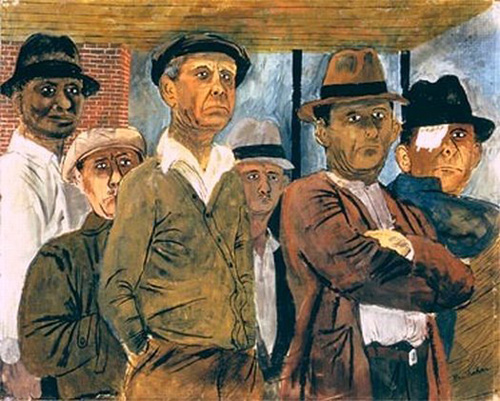
Ben Shahn, Unemployed, 1938
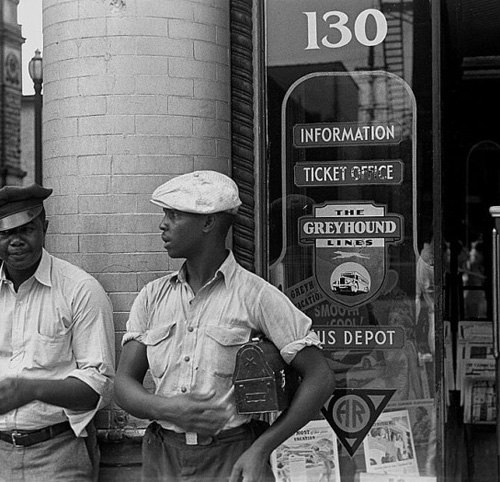
Ben Shahn, Bus station, Ohio. 1938
A.R.: The legend of modernism glorifies this shift that took place in the early Fifties from the long tradition of American social realism to the abstractions of the New York School as an abrupt and radical break. But your work and also Weaver´s work seem to be a convincing example of the continuity and coalescence of both traditions.
S.L.: Well, that may be true. Regardless of what kind of painting I might have done myself I was always very interested in all kinds of things. I never thought it gently that because there was a movement of one kind that the other kind of work had no place in the scheme of things. I was aware for example of the work of Otto Dix or of Balthus. So I was never overcome by the notion that simply because some people did abstractions that the other thing was dead.
A.R.: I was always curious to learn more about the relations between Weaver and the most popular artist from Pittsburgh, who was five years younger…
S.L.: You are talking about Andy Warhol? Bob used to get annoyed with Andy Warhol and the whole idea that he had conquered the world. I used to say to him that there is not very much you can do if someone wants to buy an Andy Warhol. He was very critical of him.
A.R: But in the beginnig there must have been some closer connections between Weaver and Warhol. They both were competitors in the same segment of illustration business and for some time they also shared the same manager, Dick Bahm and both were following in Ben Shahn´s footsteps at that time.
S.L.: I remember, and I forgot this: I took pictures of Andy Warhol with his mother one day. Bob took me to meet Andy Warhol and in that early period Andy Warhol was a great admirer of Bob Weaver. I remember that Bob brought some work up to Warhol´s house and he was looking at it carefully and I took some pictures of him. But in my photographs you don´t see anything clearly. You cant´t see that he is looking at Bob Weaver´s work. But I know that he talked about him with great admiration. That was before he became famous.
A.R.: It would be interesting to learn more about the artistic enviroment in which he was involved at the time you knew him. Was it rather limited to colleagues from the graphic-design field or more open? You already mentioned two painters, Robert Zelnick and Phil Pearlstein.
S.L: He was friendly with commercial people but he sometimes attended Tanager openings and met De Koonig, Pollock and David Smith. (Note: The Tanager Gallery operated from 1952 – 1962 in the Lower East Side as a cooperative outlet predominantly for abstract expressionists like Saul Leiter but also for some figurative painters like Philip Pearlstein and early Pop artists like Alex Katz or Tom Wesselmann.)
A.R.: Do you know why he never showed his work in an exhibition? Was it because of ideological or conceptual reasons?
S.L.: He would have liked to have an exhibition. I thought he deserved it but I was not in the position to arrange to have anything. There was a store window where people used to have shows of their work, I believe it was on Broadway and 11th or 12th street. And very often when we went by he said he would love to have his work shown there; but he never had it. I don´t know why. Bob was not traditionally the kind of artist who had exhibitions.
A.R.: What do you mean by that ?
SL.: He simply was more interested in being an illustrator than he was in being a fine artist – whatever that means.
A.R.: Most of Weaver´s ideas revolved around temporal qualities, sequentiality and simultanity and not so much around spatial representation. Maybe that´s another reason.
S.L.: Yes, I know he was involved in certain ideas. I´m not an expert on everything he did later. I thought his ideas where interesting. He deserved to be known.
A.R.: Don´t you think it strange or funny that also after the experiences of Pop Art and the influence of cultural studies, art history still seems to constitute and legitimize itself mainly by a fundamental separation between high and low, that is by ignoring the major impulses deriving from commercial arts and other popular „low“ sectors?
S.L.: You think there is too much of a separation? It maybe. As far as I´m concerned I´ve been very often impressed by certain commercial people who do quite unusual things. You see, I don´t think life is fair and many things who deserve attention don´t get it and some things have too much attention. For instance, I saw occasionally in an auction catalogue a beautiful unusual illustration by Juan Gris when he was quite young, quite superb, very, very good. I never heard that he did those kind of things. Than I heard also Franz Kline used to make illustrations. Someone could do a very interesting show about the early work of certain fine artists, when they were doing commercial things. Could be an interesting show, don´t you think?
AR: Of course. – Juan Gris used to work together with other artists like Frantisek Kupka or Felix Vallotton for the French satire magazine L´assiette au beurre. To Weaver this magazine represented a major example of his ideal of an artistic and autonomous mode of illustration. Moreover, he deduced his self-confidence as an illustrator from the insight that American fine art was substantially founded on illustration business, from Winslow Homer on.
S.L.: The trouble with art history is: They take ideas and divide things up and when someone comes along who does not fit in their categories, then they don´t know where to put him and sometimes instead of putting him, they forget him and ignore him. The history of art is full of ups and downs. So when I heard that Bob Weaver is remembered I was very delighted. – Don´t you think life is very strange, that we sit here and talk about Bob?
(December 17, 2011 / February 3, 2012)
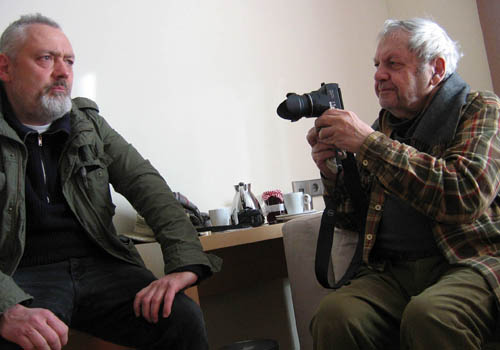
Alexander Roob – Saul Leiter (photo: Lena Roob)
Part III:
Robert Weaver:
THE VOGELMAN DIARY
IT IS AS EASY TO DO /
AS IT IS TO SAY.
————————–
DREAMING BEGINS WITH /
THE ACT OF FALLING.
————————————-
IN DREAMS IT IS ONLY THE /
FEAR OF FALLING THAT /
PREVENTS YOU FROM FLYING. /
YOU STAND AT ROOFEDGE /
YOU DO NOT LOOK DOWN IN
PANIC /
AND YOU CAST YOURSELF INTO /
WELCOMING AIR.
——————————————
THE WILLING SUSPENSION OF I . /
IT IS NOT A MATTER OF /
MASTERY BUT RATHER OF /
SURRENDER
—————————————
FLYING IS PASTORAL – EXPRESSING /
PERHAPS A LONGING FOR/
REUNIFICATION WITH THE PRE-/
HISTORIC LANDSCAPE.
—————————————
IT IS IMAGINATION OVER PRAC- /
TICALITY. SPIRIT OVER FLESH.
—————————————-
THE BEST TIME TO TELL /
STORIES TO CHILDREN IS WITH /
THE LIGHTS OUT.
——————————
THE SCENERY IS MORE /
COLORFUL ON RADIO THAN ON T.V. /
TALES ARE BEST ILLUSTRATED /
IN THE HEAD.
———————————
IF THERE WERE NO UN-/
SOLVED MYSTERIES – THERE /
WOULD NO LONGER BE A /
NEED FOR ART.
——————————–
FLYING IN DREAMS IS A SUBJECT /
CLOAKED IN DARKNESS
—————————–
TO THE BEGINNER IT MUST /
BE POINTED OUT THAT FLYING /
HAS NOTHING TO DO WITH AERO- /
DYNAMICS
———————————–
NOR IS ATHLETIC SKILL INVOLVED – /
ONLY MINIMAL EXERTION OF /
THE HANDS
—————————————-
WEIGHTLESNESS, LIKE INVISIBILIY, /
IS AN IMPOSSIBILITY TRANS- /
FORMED INTO FACT.
—————————————–
ANGELS DO NOT NEED WINGS
—–
MUHAMMAD ALI TELLS THE STORY /
OF THE AIRLINE ATTENDANT WHO /
ASKED HIM TO FASTEN
—————————————–
HIS SEAT BELT. “SUPERMAN DONT /
NEED NO SEATBELT,” HE ANNOUNCED. /
“SUPERMAN DONT NEED NO /
AIRPLANES, NEITHER.” WAS THE REPLY.
———————————————
WORDS LIKE `LIFT`, `BUOYANCY´, /
`UPDRAFT´ ETC., EXPERIENCED IN /
THE SEAT OF THE PANTS BY EARLY /
AVEATORS ARE IRRELEVANT.
——————————————-
THE KIND OF FLYING UNDER /
DISCUSSION HERE IS FLYING MINUS /
THE GRAVITY FACTOR.
——————————————
IN THE WAKING MIND´S EYE, LAUNCH- /
ING ONES SELF FROM A ROOFTOP /
MUST INEVITABLY BE FOLLOWED /
BY UPRUSHING UNSTOPPABLE GROUND-
————————————–
WITH ONLY THE INVENTION OF /
SOME FORM OF TECHNOLOGY TO /
SPARE US A MESSY CONCLUSION.
———————————-
FLYING IN DREAMS, LIKE DREAMING /
ITSELF, IS UNREGULATED, UN- /
CHARTERED AND UNSHEDULED /
AND THEREFOR –
————————————-
IS ILLEGAL AND TO BE DIS- /
MISSED OUT OF MIND. THE /
MIND TURNS A BLIND EYE ON /
THIS FLOUTING OF PHYSICS.
———————————-
YOU BEGIN YOUR SAIL ACROSS /
TOWN, IGNORING ITS GRID OVER /
TARBEACH SUNBATHERS, CLOGGED /
TRAFFIC ARTERIES, AFTERNOON BASEBALL
————————————–
STAYING CLEAR, OF COURSE, /
OF AIRPORTS. FURTHER OUT /
YOU SWIM OVER WALLED – IN /
ESTATE GROUNDS AND THEIR /
ASTONISHED SLEAZY BARKING DOGS
—————————————–
– AND PRISON YARDS, HIGH-SECURITY /
WEAPONS PLANTS, AND GAME PRESERVES.
——————————————-
SET DOWN UPON THE FAMILIAR /
CARTOGRAPHIC ARRANGEMENTS OF /
EXPRESSWAYS, RIVERS, RAILROADS AND
——————————————–
BORDERLINES IS AN OVERLAY /
OF NEW CONNECTIONS, RANDOM CRISS- /
CROSSING RESEMBLING A CHILDS
———————————————-
DRAWING, WHAT ONCE WAS A /
MAP TURNS INTO ABSTRACT ART- /
AN AFGHAN WAR CARPET WHOSE /
STORIES NO LONGER MATTER
———————————————
A TOWN IS NO LONGER A /
SERIES OF FIXED-PERSPECTIVE /
VIEWS /
BUT IS ABSTRACT SCULPTURE.
——————————————
YES, IT IS A HELICOPTER RIDE –
BUT WITHOUT THE EAR-SHATTERING /
RACKET. /
THE DREAMING FLYER
——————————————–
CASTS NO SHADOW AND PRO- /
DUCES NO ENGINE NOISE.
LIKE THE BALOONIST
————————————–
HE CAN HEAR, DISTILLED, COMING /
UP FROM THE GROUND, THE SOUNDS /
THE WORLD MAKES.
—————————————
ARTISTS DREW AERIAL VIEWS OF /
CITIES AND TOWNS LONG BE- /
FORE THE INVENTION OF BALOONS.
————————————-
IS IT SO IMPROBABLE THAT /
THEY DID NOT SO MUCH IMAGINE/
THEM AS THEY DEVELOPED,
——————————————
IN PRE-PHOTOGRAPHY TIMES, /
A TECHNIQUE FOR REMEMBERING /
THEIR DREAMS?
—————————————-
OWNERS AND COLLECTORS OF SMALL /
PLANES – LIKE THE TIGERMOTH – /
ARE REALLLY COLLECTORS OF TOYS. /
INAMORED MORE OF THE
—————————————–
BRIGHT PAINT, THE POLISHED TEAK, /
THE HAND-CRAFTED UPHOLSTERY THAN /
OF FLYING.
——————————————-
IT IS NOT THE FELLOWSHIP OF /
OWLS AND FALCONS ONE JOINS, /
NOR THAT OF GULLS OR DUCKS –
——————————————-
FOR THE SOLO SOJOURNER IT /
IS FLIGHT ITSELF – NOT /
HUNTING OR ARRIVING AND DE- /
PARTING – THA IS THE LURE.
—————————————–
DREAMING IS CONTINUOUS- LIKE /
THE UNROLLING OF A /
CHINESE LANDSCAPE SCROLL –
—————————————-
VISUAL, SPATIAL, MOVIE LIKE.
—————————————–
WAKING, ON THE OTHER HAND, /
IS MORE LIKE THE BOUND /
BOOK WHICH REPLACED THE /
SCROLL 1800 YEARS AGO –
——————————————
THAT IS – DISCONTINUOUS, VERBAL /
MORE EFFECIENT AND REQUIR- /
ING LESS HAND EXERTION
————————————–
THE SCROLL (DREAMING) DIFFERS /
FROM A MOVIE, HOWEVER, IN THAT /
IT IS PRIVATE AND VIEWER-CONTROLLED
—————————————–
FLYING IN DREAMS IS A META- /
PHOR FOR THE ACT OF /
DREAMING ITSELF
——————————————–
IMPLICIT IN THE GREEK WORD /
´METAPHOR´IS THE IDEA OF
——————————————-
MOVING FROM ONE PLACE TO /
ANOTHER –
—————————————–
WITHOUT BARRIERS.
————————————
THE PRECEDING ENTRIES ARE /
FROM THE DIARY OF CLARENCE /
VOGELMAN, 65, OF NEW YORK CITY, /
WHOSE BODY WAS FOUND
—————————————–
IN THE REMOTE WOODED AREA /
OF UPSTATE NEW YORK, APPARENTLY /
THE VICTIM OF A DUCK HUNTER´S /
BULLIT.
—————————————–
A LOCAL NEWS ACCOUNT INLUDED /
THE ODD DETAIL THAT HE /
CLAD ONLY IN PAJAMAS.
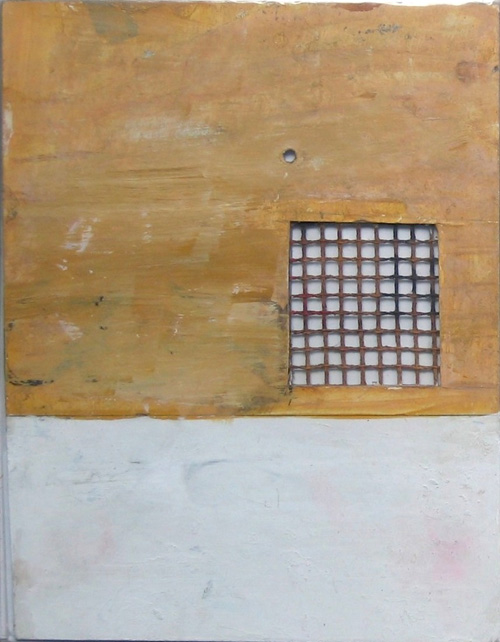
Robert Weaver, A Pedestrian View / The Vogelman Diary, 1982 (Plate 44)
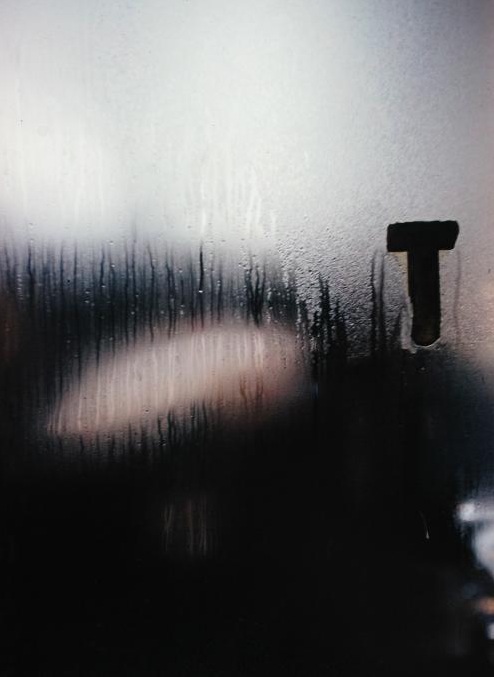
Saul Leiter, ‘T’ (1950)
All images by Saul Leiter: Courtesy Howard Greenberg Gallery
All images by Robert Weaver: Estate of Robert Weaver
Thanks to Margit Erb, Theo de Feyter, Ben Katchor, Clemens Krümmel, Saul Leiter, Antonia Pelaez and Francesca Weaver
